Back to Journals » Journal of Multidisciplinary Healthcare » Volume 15
Analyzing Community Care Research Trends Using Text Mining
Authors Park Y, Park S , Lee M
Received 16 March 2022
Accepted for publication 4 July 2022
Published 15 July 2022 Volume 2022:15 Pages 1493—1510
DOI https://doi.org/10.2147/JMDH.S366726
Checked for plagiarism Yes
Review by Single anonymous peer review
Peer reviewer comments 2
Editor who approved publication: Dr Scott Fraser
Yoonseo Park,1 Sewon Park,2 Munjea Lee2
1Department of Bio Medial Engineering, Ajou University, Suwon, Republic of Korea; 2Department of Medical Humanities and Social Medicine, Ajou University School of Medicine, Suwon, Republic of Korea
Correspondence: Munjea Lee, Department of Medical Humanities and Social Medicine, Ajou University School of Medicine, Suwon, South Korea, Tel +82-31-219-5289, Email [email protected]
Purpose: This study utilized text mining to analyze research trends around community care, which focuses on improving patients’ quality of life by lessening the financial burden on caregivers and relieving patient discomfort.
Methods: To examine research trends by community care stage, Section 1 is set from 2017 to 2019, when the community care was implemented, and Section 2 from 2020 to 2021, after the end of the community care. Papers used for the analysis were extracted using the Korea Citation Index (KCI); a total of 132 articles were selected and subjected to text mining analysis.
Results: First, the main community care research areas included work, housing, economy, disability, and mind. Second, from 2017 to 2019, there was considerable interest in community care centered on households, and main keywords, such as nursing, family, and experience, appeared. Third, from 2020 to the present, there was high interest in community care centered on disabilities, and keywords, such as space, business, and Seoul City, appeared.
Conclusion: The results reveal the changing issues, with the implementation of community care. Overall, research has tended to focus on social and welfare systems, rather than health and medical systems. In the future, local, community-integrated health and medical care systems should be restructured and regional delivery systems established to make them more accessible.
Keywords: community care, integrated care, local community, elderly care, text mining, network analysis
Introduction
In modern society, various factors, such as the development of science and the diversification of welfare systems, have increased the life-expectancy of human beings.1 Consequently, the number of older people aged 75 and above, who are the recipients of care, is rising globally, especially in developed countries; this rapid aging of the population is also increasing the social and economic burden.2 Accordingly, the trend in long-term care provision for older adults has also changed. Modernization theory predicts that “the private or public sector will take charge of child rearing, child care, parent care, and so on, which were traditionally provided at home.”3 Indeed, with the progress of modernization, the role of providing care for the elderly has shifted away from the family—such as from their children who mostly cared for them at home—to the private sector or to society, such as in publicly funded nursing homes and hospitals. However, most older people prefer living in their own homes for the rest of their lives, even if they face functional limitations, such as physical, cognitive, and social.4
Accordingly, in November 2018, the government of South Korea announced the “Master Plan for the Integrated Local Community Care”, making efforts to universally introduce “Community Care” by 2026 under the “Integrated Local Community Care” banner.5 Community care is an important component of the comprehensive primary medical care system based in a local area. The establishment of care service provision at a local scale should enable medical staff to diagnose health needs and adjust their own proposals to the collective needs of the local population.6 However, in contrast to, for example, the UK, the first country to introduce community care and enact the Community Care Act, South Korea’s participation rate for welfare and care projects, especially in-home care services, is lower than that for nursing facilities.7 This could be because the systems for providing customized treatment services/care and rehabilitation for discharge from nursing facilities or treatment at home are insufficient.
Meanwhile, the importance of community care has increased due to problems such as new diseases, changes in social and demographic structure, increased national medical expenditure, university-hospital-centered medical systems, and disease-centered treatments. Within this framework, public healthcare plays a crucial role in making society more sustainable.8 The prolonged COVID-19 crisis has resulted in a state where there is urgent need for care services for vulnerable groups. In January 2020, South Korea was among the first countries to record a COVID-19 case. Even before the WHO declared COVID-19 a global pandemic, the total confirmed cases in South Korea exceeded 7755, falling just behind China, Italy, and Iran.9 At the beginning of the pandemic, the number of confirmed cases increased rapidly in Korea. The fatality rate of those aged 80 or older was significantly higher than that of other age groups, at 20.66%; it was 2066 times (0.01%) higher than the fatality rate of those aged 20–29 and 413 times (0.05%) higher than that of those aged 30–39.10 As the pandemic persists, interest in public healthcare continues to grow. Since another pandemic is likely to occur, the necessity for community care and public healthcare is becoming more urgent.11
Existing studies on community care primarily focus on the current status of community care, building operational plans, and comparative analysis of care types.12–14 To expand community care, which has not yet established a specific operational direction, it is necessary to analyze community care-related research in an integrated manner. By analyzing both unstructured data and community care-related papers, we intend to provide suggestions for the improvement of both current community care and future community care-related policies.15,16
Based on the analysis, this study aims to suggest a developmental direction for community care that reduces the financial burden of caregivers and improves their quality of life, as well as that of patients by relieving their discomfort. For an integrated analysis of community care, quantitative analysis will be implemented through text mining, which is used for big data analysis, alongside current approaches, such as current status analysis, case analysis, and comparisons of the perceptions of providers and beneficiaries. In text mining, various unstructured data, including quantified structured data, are accumulated, among which text data can be considered the most representative.17 It shows the overall knowledge structure of the research field, through which research trends, the relational structure between topics and keywords, and research directions can be identified. This study can, thus, contribute to an understanding of the structure of community care-related research and the relationships among the main keywords. It is possible to predict future policy shifts by analyzing changes and relationships in community care-related research topics. Through this study, we intend to identify aspects of community care research that should be most urgently advanced to solve healthcare and social welfare problems through the successful implementation and development of community care.
Theoretical Background
The proliferation of care issues has increased healthcare-related anxiety in South Korea, prompting the Ministry of Health and Welfare to promote community care. Also known as “community protection”, community care commonly refers to domiciliary care. In eldercare, it is also used to refer to aging in place (AIP); that is, when a client spends the rest of their life in the place they lived.18 With rapidly increasing demand for care due to aging, society is confronted with the problems of who should, where and how to, implement it (Figure 1).19
 |
Figure 1 Conceptual chart of community care promotion. |
The 2018 elderly situation survey conducted by the Ministry of Health and Welfare on older adults in Seoul suggested that they prefer to remain in their own residence, even if it is uncomfortable.20 However, despite the advent of the aging society and the diversification of needs, society has limitations in fulfilling universal care needs, with in-home care services only accessible to vulnerable social groups.21 The eldercare services currently provided are limited to simple housekeeping, and since the supplier is dependent on the private sector, care services are centered on facility care. In addition, they are clever and have a segmented delivery system.22 As such, there is limited opportunity to receive care in daily life or at home, so most older adults choose to be admitted to a nursing hospital to reduce difficulties in life, which increases medical expenses and is an obstacle to meeting their various needs.
In this context, the government identified four key tasks to promote Korean-style community care: housing, health/medical care, nursing care, and public/private services. The Ministry for Health and Welfare unveiled the “Master Plan for Integrated Local Community Care and Promotion Plan for Leading Projects” to improve medical, housing, and care services such that older adults can receive welfare and service benefits tailored to their individual needs and live comfortably in their residence.23 After a leading project in eight local government districts in June 2019, a pilot project was implemented in 16 districts by 2020. The project aims to build a foundation for community care before Korea becomes a super-aged society in 2025,24 to help improve people’s quality of life in old age and to enable their families to focus on their own economic and social activities, free from the mental, physical, and economic burden of eldercare.
Research on community care has been actively conducted only since 2018, when the Ministry of Health and Welfare began to promote community care in order to provide in-home care services. Korean literature and discourse have, thus far, focused on case analysis, community care provision measures, analyses of factors affecting the selection of nursing facilities, and models used elsewhere. Kim Yong-deuk introduced the British community care model before community care was discussed in earnest in Korea, and suggested measures to promote user participation in welfare services for the disabled.25 Kim and Yun analyzed overseas community care cases in Japan and the UK to present a model for the sustainability of Korean-style community care.26 In addition, Hwang analyzed measures to link community care with integrated case management. These studies focus on the methods of providing community care and the intention to avail of it.27 Seo and Kim presented a community health welfare care model as an effective way to expand the participation of older adults, the main target of community care. By examining the role of the care manager and how the public–private partnership system in the relevant community functions and is linked, a plan to activate community care was sought.28 In view of this, it is necessary to prepare evidence justifying future policy directions in community care through an integrated analysis of future community care research trends.
This study intends to apply network analysis, a text mining method, and topic modeling to the keywords of research papers.29 Text mining is widely used for big data analysis as it can arrange synonyms and polysemies in research trends and identify hidden topics in the literature. It is an algorithm that supports the discovery of new knowledge.30 Text mining comprises data processing and data analysis phases. The former involves tasks such as information retrieval, information extraction, and natural language processing; the latter extracts meaningful information from the text by utilizing data mining, machine learning, and statistics, among other tools.31 Text mining analysis techniques include morphological analysis, opinion mining (emotional analysis), and topic modeling.32 Topic modeling analyzes the main topic in a specific document by applying probabilistic statistical analysis, which is used to analyze vast amounts of unstructured text.33
The most commonly used topic modeling method is Latent Dirichlet Allocation (LDA), wherein each document is expressed as a mixture of topics and each topic as a mixture of words.34
Machine learning–based research methodologies, such as text mining, can identify new perspectives on accumulated data and make the predictive analysis of the future possible. This study uses text mining to anticipate the future direction of community care, deriving topical keywords from each paper. This will enable us to objectively examine research trends by topic and period, understand the results in an integrated way, and derive new meanings by visually expressing the results.
Materials and Methods
Research Model
The research model is Figure 2. First, the papers registered in the KCI journal were collected, with “community care” as a keyword, and then preprocessed with a morpheme analyzer to extract nouns to be used in the analysis. Second, the core keywords were extracted by dividing them into “2017–2019” and “2020–2021”, to investigate the change in research trends. Third, for the refined keywords, the influence of specific keywords was identified by conducting degree centrality and betweenness centrality analyses. Finally, using topic modeling, trends in research topics related to community care policy implementation were identified before topic analysis was performed. Using the NetMiner 4.4 program, network analysis, frequency analysis, keyword network analysis, and topic modeling were conducted, with simultaneous visualization (Figure 2).
 |
Figure 2 Research model. |
Analysis Target
Since the research field of community care is multidisciplinary, including medical science, health science, and policy studies, papers on community care published in domestic Korean journals in any field were set as the analysis target. Currently, Korean academic search engine sites include RISS, DBpia, and KISS; however, for this study, the KCI was selected, and research papers with community care as a keyword and published in academic journals registered in the KCI were utilized. The KCI calculates the influence of academic journals and the citation frequency required for managing research resources; thus, it is used as a tool to evaluate the quality of research papers. The document type was “article”, the language was English, and the search scope was set to abstract.
The collection period was from 2017, when the eldercare services began in earnest, to June 2021. As a result of the search, 24 duplicate articles were removed, leaving a total of 132 articles. These were divided into two sections chronologically to examine research trends according to changes in community care over time. Section 1 was set from 2017–2019, the year when the community care leading project was implemented. Section 2 was set from 2020 to June 2021, the period after the main community care project was implemented. In all, 58 papers were published from 2017–2019 and 74 from 2020 to 2021, revealing an increasing trend. The results of the search for papers using community care as a keyword on the KCI are Figure 3.
 |
Figure 3 Papers by year. |
Results
Keyword Frequency Analysis
Keyword frequency analysis is a method of extracting frequently used words from specific documents and analyzing their importance according to the frequency of mention. In this study, keyword frequency analysis was performed by refining the abstracts of the collected research papers into noun-type words, and changes in keyword distribution and research trends were examined by section, Insert Table 1. A total of 25 keywords were extracted in Section 1 (2017–2019); the keyword that appeared the most was work (29 times), followed by residence (27 times), economy (23 times), space (22 times), experience (20 times), and others. In other words, keywords such as work, residence, and economy appeared before the community care project was enforced, suggesting that research during this period had primarily been conducted on the provision of residential space and economic support. Furthermore, considering that keywords such as in-home care, mind, dementia, home, and nursing were extracted, we can identify that the need for research on in-home care services in eldercare, home and nursing services for dementia, and so on is being raised.
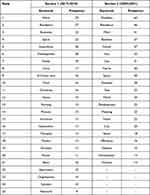 |
Table 1 Keyword Frequency |
A total of 21 keywords were extracted in Section 2 (from 2020 to June 2021); the keyword that appeared the most was disability (63 times), followed by residence (46 times), mind (41 times), business (37 times), and center (37 times), among others. Studies on residential spaces that could provide community care for the disabled and physically and mentally ill patients has been actively conducted since the enforcement of the community care project. Additionally, as compared to Section 1, visit, smart, Seoul City, and others were extracted as new keywords, revealing that research might have been conducted on visitation and remote treatments using smart healthcare since the implementation of the community care project. Meanwhile, Seoul city government is promoting “Seoul Care”, or Seoul-style community care. Since related research is being actively conducted for the development of a community care model, Seoul was extracted as a main keyword (Table 1).
Keyword Network Analysis
Degree Centrality Analysis
To comprehend research trends in community care, keyword network analysis was applied to the extracted keywords. Degree, betweenness, and closeness centralities are mainly used as measurement indicators to understand the properties of the connection structure between keywords in a network analysis. In this study, we intended to measure the centrality of one node and then calculate the degree centrality, which measures the magnitude of influence as the number of connected links increases, and the betweenness centrality, which confirms that centrality plays a mediating role between different nodes.
The results of degree centrality measurement of keywords from 2017 to 2019 are Figure 4. The closer the keyword to the center of the circle, the higher its degree centrality. Home, nursing, family, experience, space, in-home care, emotion, organization, residence, and environment are keywords with the same degree centrality. This can be interpreted as representing studies conducted on the provision of measures and sustainability of social security systems (eg, in-home care services) in preparation for the upsurge of care expenditures caused by rapid population aging. In addition, keywords such as economy, dementia, mind, and insurance were found to have very little degree centrality. Indeed, it is judged that research on eldercare services, including studies about dementia, a typical disease of older people, has been insufficient (Figure 4).
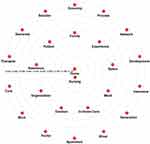 |
Figure 4 Degree centrality visualization 2017–2019. |
Next, the results for keyword degree centrality from 2020 to June 2021. The closer the keyword to the center of the circle, the higher its degree centrality. Space, mind, business, disabled, and disability were found to have high degree centrality; by contrast, nursing, work, city, use, smart, center, and chronic are farther from the center, suggesting a low degree centrality. The currently implemented community care project utilizes artificial intelligence (AI), information and communications technology (ICT), and Internet of Things (IoT) for smart medical care. Specifically, smart healthcare products are being used to manage chronic disease patients, who require continuous care. However, research on the provision of visiting medical care, where treatment and nursing are done at home, and smart home medical care services is insufficient (Figure 5).
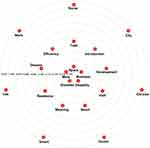 |
Figure 5 Degree centrality visualization 2020–2021. |
Finally, Table 2 shows the results of analyzing the degree centrality index of keywords derived in Section 1 (2017–2019) and Section 2 (2020–2021), respectively. The keywords with the highest degree centrality index in Section 1 were household (0.125000), nursing (0.125000), family (0.083333), experience (0.083333), and space (0.083333). Thus, since the implementation of eldercare service in 2017, there has been more research on the provision of home care compared to facility care. In Section 2, the keywords with the highest degree centrality index were space, business, disability, and disabled, all of which have the same index of 0.150000, indicating that more studies were found on the provision of community care for the developmentally disabled and older adults with disabilities after the promotion of community care. In addition, keywords such as task, introduction, and Seoul, which did not appear in Section 1, showed a high degree centrality index in Section 2. By contrast, the degree centrality index of keywords such as nurse, city, chronic, and smart was lower. This means that community care is being implemented by region, centered on the city to provide care services, whereas active promotion seems necessary for smart home service projects that use visiting medical care, AI, and IoT technologies (Table 2).
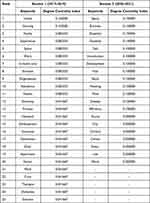 |
Table 2 Keyword Degree Centrality |
Betweenness Centrality Analysis
Betweenness centrality is used to find a mediator that acts as a bridge between nodes. As a certain node is more closely found on the most-frequent course between other nodes in the network, the betweenness centrality of the node becomes higher. The results of measuring the betweenness centrality of keywords from 2017–2019 are Figure 6. The keywords with high betweenness centrality were nursing, followed by family, home, experience, emotion, space, and in-home care. Some of the keywords with a long distance between nodes are economy, solution, dementia, therapist, cure, organization, and mind. This suggests that there is still insufficient research on reducing the economic burden of patients and caregivers through community care and establishing a community care model, including treatments for common diseases in the older population (Figure 6).
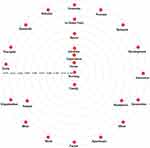 |
Figure 6 Betweenness centrality visualization 2017–2019. |
Next, the results of measuring the betweenness centrality of keywords from 2020 to 2021 are Figure 7. The keywords with high betweenness centrality for community care from 2020 to 2021 were Seoul, mind, residence, space, and business, with disability at the center. Keywords such as nurse, chronic, city, visit, center, smart, use, and work had lower betweenness centrality. This could indicate that comprehensive in-home care services for older adults, including those with chronic diseases, and treatment by visiting medical staff and care services, are insufficient; this will have to be addressed to promote community care projects in the future (Figure 7).
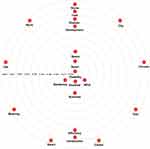 |
Figure 7 Betweenness centrality visualization 2020–2021. |
Finally, the results of analyzing the betweenness centrality index of keywords derived in Section 1 (2017–2019) and Section 2 (2020–2021) are Table 3. In Section 1, nursing (0.148551), home (0.130435), family (0.126812), and experience (0.115942) had the highest ranking, followed by emotion (0.097826), space (0.0724664), in-home care (0.039855), and residence (0.039855). The keywords with the lowest betweenness centrality included economy, network, generation, silver, dementia, and mind, at 0.000000. This suggests the need for more research on the provision of community care for dementia treatment.
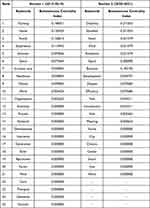 |
Table 3 Keyword Betweenness Centrality |
In Section 2, the keywords with the highest betweenness centrality were disability (0.271053), disabled (0.271053), Seoul (0.231579), and mind (0.231579). If there were more research on the development of the “Seoul-Type Community Care” model currently being implemented in Seoul for the disabled, elderly, and chronically ill, then it would be possible to utilize the measures based on this model to complement the current community care project. By contrast, keywords with lower betweenness centrality index included nurse, city, chronic, center, and smart, all at 0.000000. This result suggests that it will be necessary to provide consumer-oriented community care, including visitation treatment and nursing provision (Table 3).
Topic Modeling Analysis
Topic Analysis
After text preprocessing, topics were extracted using the LDA topic modeling method. For 2017–2019, four topics were extracted. Of these, the biggest topics were work, cure, home, patients, and nursing. This suggests that more emphasis was placed on patients receiving treatment and nursing care at home through occupational therapy services, which are focused on improving the vital function of the community care system. This finding shows that there is research activity surrounding the topic of work as an activity one engages in, just like sleep and rest, self-help activities, house-making, play, education, production activities, leisure activities, and social participation.
After analyzing the topics for 2020–2021, four topics were extracted. The biggest topics were disability, development, mind, and center. This result suggests a high level of interest in community centers for the developmentally disabled and older adults with disabilities who are severely restricted in their daily or social life (Table 4).
 |
Table 4 Topic Analysis 2017–2021 |
Topic–Word Network Analysis
The TON is a two-mode network between all topics and words, where the topic-associated probability of all words has a value of at least 0. This means that all word–topic links exist. Therefore, it consists of words that are in the top 30. First, as a result of analyzing Section 1 (2017–2019), Topic-1 was found to use work as the big keyword, followed by development, cure, home, therapist, nursing, and patient. Topic-2 had residence as the big keyword, followed by space, in-home care, mind, generation, silver, and customization. Topic-3 had economy appear as the big keyword, followed by experience, insurance, process, emotion, organization, and apartment. Finally, Topic-4 produced family as the big keyword, followed by dementia, data, trauma, solution, factors, and network (Figure 8).
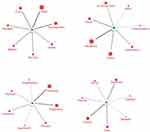 |
Figure 8 Topic–word network analysis for 2017–2019. |
Next, the topic–-word network in Section 2 (2020–2021) shows that guarantee was the big keyword in Topic-1, followed by business, task, meaning, smart, dementia, and city. In Topic-2, center was the biggest keyword, followed by suicide, efficiency, long-term, small-scale, and introduction. In Topic-3, disability was the biggest keyword, followed by residence, mind, disabled, space, development, and rural district. Lastly, in Topic 4, nurse appeared as the biggest keyword, followed by work, visit, use, Seoul, chronic, and disease. Among the degree centrality visualizations, the word connected to Topic-2 and Topic-4 is use, which was extracted as the main word with a high weight. Use can thus be viewed as a mediating word connecting Topic-2 and Topic-4, closely related to both topics (Figure 9).
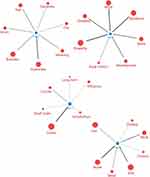 |
Figure 9 Topic–word network analysis for 2020–2021. |
Discussion
This study used text mining to analyze research trends in 132 research papers on community care from 2017 to 2021. To this end, a keyword network analysis and an LDA-based topic modeling were performed, producing the following results.
First, among the extracted keywords, appearance frequency was high for work, residence, economy, space, experience, and development from 2017–2019; keywords such as disability, residence, mind, business, center, and visit appeared frequently from 2020–2021. For those in need of care, such as the elderly, chronically ill, and disabled, who wish to live in their own place of residence and are eligible for the community care project, issues such as the construction of residential spaces and promotion of support policies have also been reflected in studies. In the future, it will be necessary to pay attention to discussions on these keywords and draw solution tasks.
Second, as a result of keyword connection centrality analysis, from 2017 to 2019, top keywords came out in the order home, nursing, family, experience, space, and work, and from 2020 to 2021, space, business, disability, disabled, and task introduction. These keywords contain the core meaning of community care research, because they appear frequently with other keywords. This shows that as community care is centering on nursing, health, and medical services, visiting medical services are expanding and discussions are underway on the future roles of medical personnel such as doctors and nurses. However, as a result of the mediation center, keywords appeared in the order nursing, home, family, experience, emotion, and space from 2017 to 2019, and from 2020 to 2021, disability, disabled, Seoul, mental, residential, and space. The centrality of mediation refers to a concept that gradually expands to other concepts by acting as a mediator connecting concepts and concepts of high keywords. From this, it can be observed that recognition of the necessity of community care is growing due to the increasing demands of local communities to address physical, mental, and social problems, such as the needs of the disabled.
Third, four topics were extracted from the topic analysis. The biggest topic from 2017–2019 was work, followed by cure, home, patient, and nursing. Disability, development, mind, and then center showed the highest proportion from 2020–2021. To date, community care research on seeking improvement-oriented occupational therapy services that play a vital function within the community care system has been conducted. This research focuses on the treatment and provision of nursing care for patients staying at home. Moreover, it examines the interest rate in community centers for people with developmental disabilities and disabled seniors.
Fourth, the topic–word network appeared relatively even. The keyword with the highest appearance frequency was work, and the keyword with a relatively low appearance frequency was home. While early community care studies tended to focus on government policies and promotion projects, the role of visiting medical services, such as occupational therapy and nursing, has expanded within the community care system since the promotion of the community care project. Therefore, it is necessary to create a community care policy system in which the establishment of the public healthcare system and the management of health-vulnerable people are carried out simultaneously. In addition, government financial support should be expanded to play a leading role in this regard. Research on various topics, including in-home care—a social security system that could prepare the community for a surge in care expenditures due to rapid aging, among other reasons—has also been carried out.
The limitations and research directions of this study are as follows. First, although the community care research literature has expanded markedly since 2017, it is still lacking in terms of the number of studies and diversity of coverage. If additional research is conducted and the studies are more heterogenous, an in-depth analysis would be possible beyond the limitations of basic research. By subdividing the analysis target, research trends can be analyzed from various fields and perspectives, including government policies, social enterprises, and local government projects. Second, the analysis target in this study was limited to the keywords and abstracts of the Korean community care research literature. If a parallel comparison between analyses of international community care studies and those of the researcher’s network are done in the future, the discussion could be enriched; advanced research results could be obtained using various text mining methods and quantitative analysis and by adding qualitative interpretations. Third, follow-up studies on promoting community care based on each extracted keyword and topic, government agencies’ promotion policies for health and medical care, social welfare, and more can be expected. Additionally, for the policy success of community care, above all, it is necessary to actively discuss community care needs and develop them into policy demands. Particularly, the demand for decentralization in the health and medical fields and the need for balanced national development in these fields should be considered. Nevertheless, this study is meaningful, as it comprehensively organizes community care–related studies. It contributes to the development of community care research by identifying research trends to date, suggesting the implications of the research topics, and providing future research directions.
Conclusion
In the selection of future research topics, it is necessary to comprehend the trends surrounding high central keywords, such as work, residence, economy, space, business, disability, and disabled. New areas of research can be created by combining these keywords. In addition, if keywords connecting each extracted topic are used as a medium, it will expand the research on community care and its applications.
This study’s findings can be used to support social welfare innovation, such as social security systems, social and welfare policies, and care services. Socialization of community care will strengthen health and welfare policies; protect the human rights of the elderly, the disabled, and women; and create related jobs. Additionally, the findings provide more insight into the interest level of local residents in resolving social problems. The results can also inform the development and promotion of policies to establish sustainable care services, such as by securing participation of local residents. However, the reason community care remains the leading project even after its promotion is that it is only being conducted within the social welfare system. There is concern that it would only remain a social and welfare service and not be considered in the health and medical care system. For community care to actively operate, proactive intervention in the fields of health and medical care and changes in the medical system are necessary. In addition, residents also need to be interested in local community care policy. They must actively utilize the service for the establishment of sustainable systems and the implementation of policies that respond to the issue of a rapidly aging society. The local community-integrated health and medical care systems must be restructured, and various regional delivery systems must be established to make them more accessible.
Abbreviations
WHO, World Health Organization; COVID-19, coronavirus disease-2019; AIP, aging in place; LDA, Latent Dirichlet Allocation; KCI, Korea Citation Index.
Data Sharing Statement
The datasets used and analyzed during the current study are available from the corresponding author on reasonable request.
Consent for Publication
All authors approve the publication of this study. No other approval is needed.
Acknowledgments
We are grateful to the journal editors and anonymous reviewers for their time and helpful comments to improve the paper.
Funding
This work was supported by the Ministry of Education of the Republic of Korea and the National Research Foundation of Korea (NRF-2021R1I1A4A01057428) and Bio-convergence Technology Education Program through the Korea Institute for Advancement Technology(KIAT) funded by the Ministry of Trade, Industry and Energy (No. P0017805)..
Disclosure
The authors declare no conflicts of interest.
References
1. Lee S, Kim J, Ahn J, Kim S. A study on the old people complex community care space. J Korea Inst Spatial Des. 2020;15(3):117–126.
2. Carpenter I, Gambassi G, Topinkova E. Community care in Europe. The aged in home care project (AdHOC). Aging Clin Exp Res. 2004;16(4):259–269. doi:10.1007/BF03324550
3. Lee M. Factors influencing elderly persons’ expectations of using community care services. Soc Converg Knowl Transact. 2019;7(3):47–56.
4. Meng D, Xu G, Davidson,PM. Perceived unmet needs for community-based long-term care services among urban older adults: a cross sectional study. Geriatr Nurs. 2021;42(3):740–747. doi:10.1016/j.gerinurse.2021.03.013
5. Park S. A study on tasks for planning community care in local government and priority analysis using AHP: focusing on the case of Seongnam City. GRI Rev. 2020;22(1):61–86.
6. Iosti P. Territorialization of care and proximities in a community-based primary care system: what are the results on access to care and resident satisfaction? A case study from São Paulo. Health Place. 2020;66:102451. doi:10.1016/j.healthplace.2020.102451
7. Son M, Cho J, Young K, Kim M. Community care perceived by medical welfare service providers and residents dwelling in the community. J Converg Inform Technol. 2020;10(6):200–208.
8. Xiang Y, Chen L, Guo L, Shu B, Long E. COVID-19 epidemic prediction and the impact of public health interventions: a review of COVID-19 epidemic models. Infect Dis Mod. 2021;6:324–342.
9. Lee D, Choi B. Policies and innovations to battle Covid-19 – a case study of South Korea. Health Policy Technol. 2020;9(4):587–597. doi:10.1016/j.hlpt.2020.08.010
10. Kim J. Cases and issues in caring for older adults using AI/robots during the COVID-19 pandemic in the U.S.. Global Soc Secur Rev. 2021;16:16–26.
11. Jeon B, Kim N-J. A study on the medical services use of elderly with chronic diseases in the COVID-19 pandemic. J Wellness. 2022;17(1):179–185. doi:10.21097/ksw.2022.2.17.1.179
12. Park E, Kim N, Ta Park VM, Rhee Y. Caregiving for community-dwelling older persons in South Korea: current formal and informal care use and expectation. J Appl Gerontol. 2020;39(4):398–403. doi:10.1177/0733464819866360
13. Kwak M, Kim B, Lee H, Zhang J. Does gender matter in the receipt of informal care among community-dwelling older adults? Evidence from a cross-national comparative study across the United States, South Korea, and China. J Gerontol Ser B. 2021;76(Supplement_1):S64–S75. doi:10.1093/geronb/gbaa018
14. Kim E, Lee M, Kim E-H, et al. Using knowledge translation to establish a model of hospital-based early supported community reintegration for stroke patients in South Korea. BMC Health Serv Res. 2021;21(1):1–13. doi:10.1186/s12913-021-07400-5
15. Chintalapudi N, Angeloni U, Battineni G, et al. LASSO regression modeling on prediction of medical terms among seafarers’ health documents using tidy text mining. Bioengineering. 2022;9(3):124. doi:10.3390/bioengineering9030124
16. Hendrickx I, Voets T, van Dyk P. Using text mining techniques to identify health care providers with patient safety problems: exploratory study. J Med Internet Res. 2021;23(7):e19064. doi:10.2196/19064
17. Kim S, Kang J. The status of using text mining in academic research and analysis methods. J Inform Technol Archit. 2016;13(2):317–329.
18. Hwang MJ. Welfare of the aged and community care in an aging society. J Public Soc. 2020;10(2):5–28. doi:10.21286/jps.2020.05.10.2.5
19. Isenberg SR, Killackey T, Saunders S, et al. “Going home [is] just a feel-good idea with no structure”: a qualitative exploration of patient and family caregiver needs when transitioning from hospital to home in palliative care. J Pain Symp Manag. 2021;62(3):e9–e19. doi:10.1016/j.jpainsymman.2021.02.026
20. Kim J. Older adults’ perspectives on chronological definition for old age. Korean J Res Gerontol. 2019;28(2):109–117. doi:10.25280/kjrg.28.2.5
21. Lee J. Comparative analysis of community care policy for the elderly in Korea and Japan: focused on the Gilbert & Terrell analysis model. J Hum Soc Sci. 2020;11(3):149–162.
22. Yoon K, Lee M. Comparative analysis of factors affecting quality of community-based care services in Korea. Int J Environ Res Public Health. 2022;19(8):4641. doi:10.3390/ijerph19084641
23. Kim B. Transition of elderly welfare policy: transition from home welfare facility to community care and implications for Gyeongsangbuk-do. Korean J Polit Sci. 2020;28(4):49–72. doi:10.34221/KJPS.2020.28.4.3
24. Jang J, Cho J-W, Kim,Y-J, et al. Preliminary study for the development of a visiting oral health care intervention program for the elderly based on community healthcare. J Korean Acad Oral Health. 2020;44(3):166–172. doi:10.11149/jkaoh.2020.44.3.166
25. Kim Y. Issues on user participation in Korean disability services: implications from UK community care. Korean J Soc Welf. 2005;57(3):363–387.
26. Kim Y. Case study of community care: policy implications from Japan and UK. J Crit Soc Welf. 2018;60:135–168. doi:10.47042/ACSW.2018.08.60.135
27. Hwang MK. A study on the linkage and network plan of integrated care management with community care. Korea Acad Care Manag. 2019;30:161–184.
28. Seo DH. A study on the community health and welfare care system in the aged society based on the big data: focused on the community care policy. J Korean Soc Welf Admin. 2019;21(1):55–81.
29. Jun YM, Kang K-J. Community care key words and social network analysis based on big data. Korean J Fam Welf. 2019;24(2):251–269. doi:10.13049/kfwa.2019.24.2.7
30. Khan AM. An approach to text analytics and text mining in multilingual natural language processing. Materials Today Proc. 2021.
31. Sayed MA, Qin X, Kate,RJ, Anisuzzaman DM, Yu Z. Identification and analysis of misclassified work-zone crashes using text mining techniques. Accid Anal Prev. 2021;159:106211. doi:10.1016/j.aap.2021.106211
32. Jung H, Lee BG. Research trends in text mining: semantic network and main path analysis of selected journals. Exp Syst Appl. 2020;162:113851. doi:10.1016/j.eswa.2020.113851
33. Li X, Fan M, Zhou Y, Fu J, Yuan F, Huang L. Monitoring and forecasting the development trends of nanogenerator technology using citation analysis and text mining. Nano Energy. 2020;71:104636. doi:10.1016/j.nanoen.2020.104636
34. Pérez F, Lapeña R, Marcén C, Cetina C. Topic modeling for feature location in software models: studying both code generation and interpreted models. Inform Soft Technol. 2021;140:106676. doi:10.1016/j.infsof.2021.106676
 © 2022 The Author(s). This work is published and licensed by Dove Medical Press Limited. The full terms of this license are available at https://www.dovepress.com/terms.php and incorporate the Creative Commons Attribution - Non Commercial (unported, v3.0) License.
By accessing the work you hereby accept the Terms. Non-commercial uses of the work are permitted without any further permission from Dove Medical Press Limited, provided the work is properly attributed. For permission for commercial use of this work, please see paragraphs 4.2 and 5 of our Terms.
© 2022 The Author(s). This work is published and licensed by Dove Medical Press Limited. The full terms of this license are available at https://www.dovepress.com/terms.php and incorporate the Creative Commons Attribution - Non Commercial (unported, v3.0) License.
By accessing the work you hereby accept the Terms. Non-commercial uses of the work are permitted without any further permission from Dove Medical Press Limited, provided the work is properly attributed. For permission for commercial use of this work, please see paragraphs 4.2 and 5 of our Terms.
